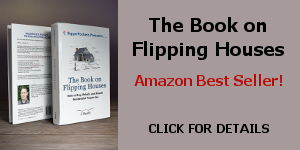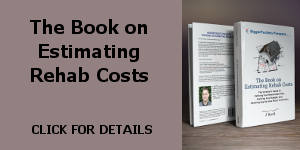Because we’re seriously considering holding The Yellow Stain House as a long-term rental, I put together a full financial analysis for renting this property to give us an idea of how lucrative this approach would be. Of course, I did a preliminary analysis a long time ago indicating that the property would work as a rental, but I hadn’t looked at the numbers in a while to determine if this approach was more optimal to other exit strategies we were considering.
Here is a how I put together a typical rental analysis (though I do all this in a spreadsheet):
Income
The total income for renting this property is basically the cumulative total of the annual rent, minus whatever amount of rent we will lose when the house is not rented (called “vacancy”). I generally assume that a property will be rented for 11 months out of the year, leaving a vacancy rate of 8.3% (one month per year). Given the average rents for other similar properties in the area, I think I can conservatively expect to rent The Yellow Stain House for $1000/month.
That’s $12,000/year, and subtracting 8.3% for vacancy, that leaves an annual income of $11,000/year.
Expenses
The next part of the equation is our total annual expenses to maintain the property, keep it in good shape, get and keep renters, etc. The following is a list of expenses that I foresee incurring from this property over the first year:
- Property Taxes: $1200
- Insurance: $800
- Maintenance/Repairs: $1500
- Advertising (for renters): $100
- Property Management: 10% of Income
- Lawn Care, etc: $600
Notice that I included Property Management (PM) in my expense estimates. While I don’t anticipate using a PM company, I like to ensure that the property is still profitable if I ever did. This way, if I ever decide to move out of state but want to keep my property, or if I accumulate enough properties that I can’t manage them all myself, I want to ensure that I can hire a PM company and still be alright financially.
For the sake of this blog post, I’m going to remove the 10% of income ($1100) per year in PM costs, as I won’t be using a PM company. In my full analysis, I ran the numbers both with and without PM costs, to make sure they made sense both ways.
The total annual expenses for this property (from above) is about $4200/year.
Loan Terms
Before we can do our analysis, it’s important that we also know our loan terms so that we can factor in the costs of loan into our equations. Here is the important information about the loan we’ll be getting:
- Purchase Price: $60,000
- Down Payment: $6000 (10%)
- Loan Amount: $54,000
- Interest Rate: 7.75% for 30 yrs
- Monthly Mortgage Costs: $387
- Annual Mortgage Costs: $4642
- Rehab Costs: $13,000
- Closing Costs: $3000
- Total Cash Investment: $22,000
That should be enough information to do our analysis.
Financial Analysis
First, we determine our annual Net Operating Income (NOI) — this is our income ($11,000 per year) minus our expenses ($4200 per year), but before we pay our mortgage:
NOI = $11,000 – $4200 = $6800
Next, we figure out our cash flow — this is our total profit after we pay our mortgage (which is $4642 per year):
Cash Flow = $6800 – $4642 = $2158
So, we now know that we will make $2158 per year, but we have no idea if that’s a good amount or not. Given that we know we will be investing a total amount of $22,000 in cash, our Return on Investment (ROI) is our cash flow ($2158) divided by our total investment ($22,000):
ROI = $2158 / $22,000 = 9.8%
So, our total return on investment is nearly 10%, which is much better than we could make by putting that cash in the bank or investing in the stock market.
If you add in the tax benefits and the equity being accrued by having our tenant pay our mortgage, the total return from this property is actually closer to 14%.
Not bad…




Most of the pm companies I’ve dealt with want to charge you a full month of rent for finding, screening and getting the lease with the renter. If this is the same in your area (I’ve seen this happening in every area I’ve looked into) then your PM costs are higher.
The good PMs want that arraignment as that is how they make the big bucks.
Have you seen any other setup?
Your ROI calculations appear to have left out principal reduction. If you get an amortizing loan, that paydown of principal will add to your return (more the longer you hold the property).
Love your blog, bro!
Thanks RealOG!
What I call the the “ROI” above is actually the “Cash On Cash” return. I made a mistake when writing this, and meant to call it the cash-on-cash instead.
Generally, I factor the tax benefits and the equity accrual (the paydown by my renters) into the “total return,” which is the 14% number.
As you point out, that’s the important number in the end, because it’s my total ROI.
Thanks for catching this!
Andres –
You’re absolutely right. Since I haven’t used PM for any properties yet, I don’t know the “real costs”. But, because of the pricing structure of good PMs, it’s probably closer to 12-15% (the higher the turnover, the more it will be).
I’ll have to increase that in my calculations from now on… 🙁